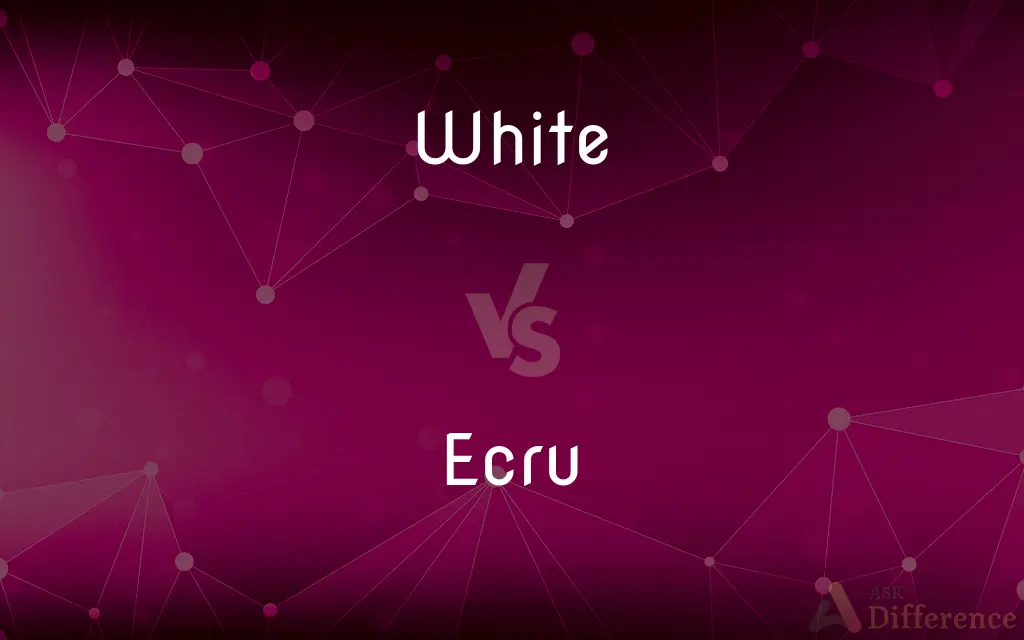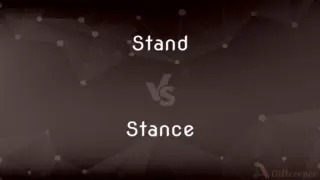White vs. Ecru — What's the Difference?
By Urooj Arif & Maham Liaqat — Updated on February 27, 2024
White is a pure, bright color with no hues, symbolizing cleanliness and simplicity, while ecru refers to a pale, light beige color, often seen as natural and understated, evoking a sense of warmth and neutrality.

Difference Between White and Ecru
Table of Contents
ADVERTISEMENT
Key Differences
White, often associated with purity and simplicity, is a color without any hues, making it a universal choice for design elements that require a sense of clarity and precision. Its brightness is unparalleled, offering a stark contrast to other colors. Ecru, on the other hand, brings a warm, natural beige tone to the table, embodying a more understated and organic vibe. This color can introduce a subtle, warm element to designs, often used to create a cozy and inviting atmosphere.
White is versatile, serving as a perfect backdrop for any color, it can sometimes feel too sterile or impersonal if overused. Its ability to reflect light can brighten spaces but also highlight imperfections. Ecru, with its inherent warmth, provides a soothing alternative that pairs well with a wide range of colors, adding depth and complexity to designs without overwhelming the senses.
White is a statement of elegance and simplicity, often worn to symbolize a new beginning or purity. It's a popular choice for formal wear, such as wedding dresses and crisp, professional attire. Ecru, conversely, offers a more relaxed, earthy feel, ideal for casual wear or textiles that aim for a natural, unbleached look.
White walls can make rooms appear larger and more luminous, serving as a canvas for artistic expression. Ecru, with its subtle, warm undertones, can create a cozy, welcoming environment, often used in spaces seeking a calm and comforting ambiance.
The perception of white as cold or clinical in some contexts contrasts with ecru's ability to evoke warmth and neutrality. This difference in emotional response highlights the importance of color choice in setting the tone and atmosphere of a space or design.
ADVERTISEMENT
Comparison Chart
Hue
No hue, pure color
Pale, light beige
Symbolism
Purity, simplicity, cleanliness
Natural, warmth, understated
Use in Design
Brightens, offers contrast
Adds depth, warmth
Fashion
Formal, elegant
Casual, earthy
Interior Design
Expands space, versatile
Cozy, inviting, neutral
Compare with Definitions
White
Common in formal attire, symbolizing new beginnings.
The bride chose a classic white dress for her wedding.
Ecru
Often used in casual and comfortable fashion.
Her ecru linen dress was perfect for a summer day.
White
Versatile in design, offering contrast.
She wore a white blouse to offset her dark suit.
Ecru
Preferred for its understated elegance.
He wore an ecru sweater for a subtle, sophisticated look.
White
Pure and bright, symbolizing cleanliness.
The white walls of the museum made the artwork stand out.
Ecru
Creates a cozy, inviting atmosphere in interiors.
The living room's ecru walls created a soft, warm ambiance.
White
Reflects light, making spaces appear larger.
They painted the room white to make it feel more spacious.
Ecru
Pairs well with a wide range of colors, adding depth.
The ecru throw pillows added depth to the colorful sofa.
White
Can be perceived as sterile or cold if overused.
The all-white kitchen felt a bit too clinical.
Ecru
Pale, light beige, evoking natural warmth.
The ecru curtains added a warm, neutral tone to the room.
White
White is the lightest color and is achromatic (having no hue). It is the color of fresh snow, chalk, and milk, and is the opposite of black.
Ecru
Ecru is the colour of unbleached linen.Traditionally ecru was considered a shade of beige, but beginning in the 19th century it became more precisely defined as "a grayish yellow that is greener and paler than chamois or old ivory". Ecru comes from the French word écru, which means "unbleached".
White
Whites Pieces of laundry having a white or nearly white color.
Ecru
The light fawn colour of unbleached linen
Shades of white, black, and ecru
An ecru cardigan
White
Whites White pants or a white outfit of a special nature
Tennis whites.
Ecru
A grayish to pale yellow or light grayish-yellowish brown.
White
Whites The white dress uniform of the US Navy or Coast Guard.
Ecru
A beige colour.
White
A white breed, species, or variety of animal.
Ecru
Of a beige colour.
White
Any of various butterflies of the subfamily Pierinae, characteristically having chiefly white wings often with black markings.
Ecru
Having the color or appearance of unbleached stuff, as silk, linen, or the like.
White
Also White A member of a racial group having light-colored skin, especially when of European origin and in some classifications also when of Middle Eastern or North African origin.
Ecru
A very light brown
White
Often whites Products of a white color, such as flour, salt, and sugar.
White
The white or light-colored pieces, as in chess.
White
A white pigment.
Venice white
White
A white bean
White
Having the color of purity; free from spot or blemish, or from guilt or pollution; innocent; pure.
White as thy fame, and as thy honor clear.
No whiter page than Addison's remains.
White
A person with a white skin; a member of the white, or Caucasian, races of men.
Common Curiosities
Is white or ecru better for small spaces?
White is typically better for making small spaces appear larger due to its ability to reflect light, while ecru adds warmth and coziness.
What is the main difference between white and ecru?
White is a pure, bright color with no hues, symbolizing cleanliness and simplicity, while ecru is a pale, light beige, evoking warmth and natural understatement.
Can ecru be considered a neutral color?
Yes, ecru is considered a neutral color, offering versatility and warmth without overwhelming a design with color.
Can ecru and white be used together in design?
Yes, ecru and white can be paired together to create a balance of warmth and brightness, adding depth and contrast to designs.
Is white more versatile than ecru in design?
White is often seen as more versatile due to its pure neutrality, allowing it to serve as a backdrop for any color, whereas ecru adds a specific warmth and tone.
Why is white often chosen for formal attire?
White symbolizes purity and elegance, making it a popular choice for formal events and significant beginnings, like weddings.
Do white and ecru have the same maintenance level?
White may require more maintenance to keep its bright, clean appearance, whereas ecru is more forgiving of stains and wear.
How do lighting conditions affect the appearance of white and ecru?
Lighting can significantly affect how these colors are perceived; white can look brighter or take on hues from surrounding colors, while ecru can appear warmer or richer.
Does ecru hide imperfections better than white?
Yes, ecru can better mask imperfections and wear due to its warmer, slightly darker tone compared to the starkness of white.
Is ecru a good choice for outdoor clothing?
Yes, ecru is a practical and stylish choice for outdoor clothing, hiding dirt and wear while offering a relaxed, natural look.
Is ecru suitable for all skin tones?
Ecru is generally flattering for a wide range of skin tones, offering a neutral backdrop that complements natural colors.
Are there any specific cultures that prefer white over ecru, or vice versa, for symbolic reasons?
Yes, cultural preferences may vary; for example, white is traditionally worn at weddings in many Western cultures, symbolizing purity, while other cultures may prefer warmer, natural tones like ecru for their natural and earthy symbolism.
How do fashion designers use white and ecru differently?
Fashion designers use white to create bold, clean looks, often in formal wear, while ecru is used for more understated, natural, and casual designs.
How does the choice between white and ecru impact the mood of a room?
White tends to create a clean, bright atmosphere, potentially feeling sterile, while ecru offers a warm, inviting ambiance, enhancing coziness.
Can the use of ecru in interior design make a room feel smaller?
While not as expansive as white, ecru can still make a room feel inviting and warm without significantly reducing the perception of space.
Share Your Discovery

Previous Comparison
Stand vs. Stance
Next Comparison
Deportment vs. ComportmentAuthor Spotlight
Written by
Urooj ArifUrooj is a skilled content writer at Ask Difference, known for her exceptional ability to simplify complex topics into engaging and informative content. With a passion for research and a flair for clear, concise writing, she consistently delivers articles that resonate with our diverse audience.
Co-written by
Maham Liaqat













































